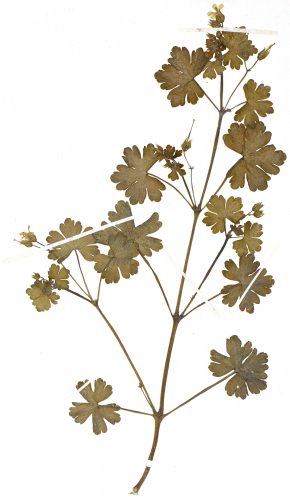
In response to my March column about the scourge of shining geranium, local resident Alan Van Zuuk has provided more detail on how to control this pernicious weed through non-glyphosate means.
Van Zuuk, who is cited in the publication mentioned at the end of my last column, writes from personal experience, so I felt it was well worth passing this information along. As he says, controlling shining geranium is “something neighbors should be doing for their neighbors to reduce the problem.”
Van Zuuk writes: “Having fought shining geranium on my own one-acre place since 2008, I can clarify some organic-certified control efforts that anybody can use with maximum effectiveness. Using the toxic and much-lied-about glyphosate herbicides on your yard or planet is chemical insanity.
“At its worst, I had shining geranium growing at up to 1 inch by 1 inch centers on 1/4 acre, in full sun, full shade, bare soil, established grass, native understory plants, gravel driveway, duff and moss. It thrives and overruns everywhere, like the creatures in Alien. It has no herbal qualities. This year I only have a couple hundred plants that are most easily pulled up when they get four inches tall. Stop this weed when you first find it or you will be very sorry.
“The leaves have the same characteristic shape from when they are 1/8 inch across, so you can easily identify them when the plant is tiny, which is the only time to use vinegar, Bonide BurnOut II or Avenger on them. Twenty percent agricultural vinegar works great; do not dilute household vinegar any further. These are organic-certified foliar herbicides that will kill the plants but only while they are 1 inch tall. Use less boiling-hot water for a reduced dilution to increase the effect, on a warmish, sunny day with no rain following for 24 hours or more. Most plants are only this small in February/March, so you have to find that weather window.
“Once the plants have grown enough the leaves overlap, you have to pull them up or remove them by hand. They pull easily; grab the plant with fingertips below the node just below the surface. In loose soils you can use a weed-whacker to rototill the soil an inch or more deep, then clean up the plants. Weed-whacking the roots works better with larger plants. Keep an eye out for returnees and new seedlings until August, when the plants just melt away. But you may also see new sprouts in the fall after it starts raining.
“Your main objective is to keep these plants from setting seeds. The seeds are viable long before they start shooting off, so always clean up the entire plant and do not put it in the compost pile. The seeds are viable in the soil for maybe three years.
“Things that don’t work: chickens, ducks, geese, one year of light occlusion with tarps or cardboard, mowing. If you damage the plant without killing it, it will set seeds faster.”
By the time you read this, it will probably be too late for vinegar treatment to be effective, but you may still be able to remove plants by hand or cultivation as described by Van Zuuk without sending seed all over the place.
I think it is important to stress that you can get rid of this plant within a limited area. But because the methods that actually work are very labor-intensive, it is simply impractical to remove it from very large areas. Van Zuuk’s successful near-eradication on 1/4 acre was heroic.
Van Zuuk has provided a more detailed account of his assaults on shining geranium in the form of an Excel spreadsheet. Contact me by email to receive that material at rfoster@efn.org.